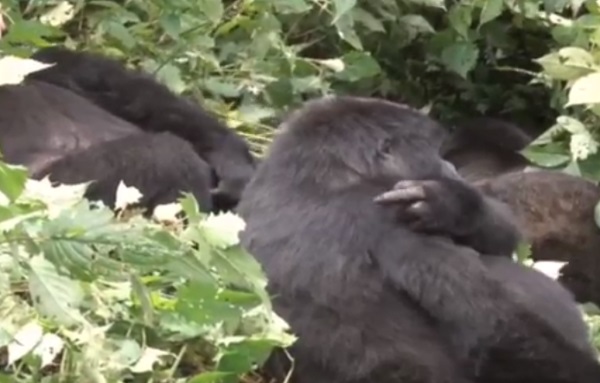It is a long and bumpy ride through the hills of South Western Uganda on the edge of the Rift Valley near Bwindi Impenetrable National Park which hosts one of the largest numbers of mountain gorillas in the world. The UN Educational and Cultural Agency UNESCO gazetted Bwindi Impenetrable forest as a National Heritage Site in 1994. It has an estimated 400 mountain gorillas and 400 plant species. As we embark on this journey our focus is not on one of Uganda’s biggest tourist attraction the mountain gorillas but the local community near the park that help protect the species. We sneaked through the terraces as we tracked the Batwa or Pigmy communities that live near the gorilla families. The Batwa are predominantly farmers, they previously lived in these forests but left generations back. After walking for at least 20 minutes in the scorching sunshine, we finally reached our destination here on the steep slopes in Rushaga village. We are with one of the families that have become the main attraction for tourists in this particular areas. Fifty-year-old Ephraim Banegura is a Mutwa, the father of six has lived here all his life. He says his role is to look after the community and also to protect the gorillas. “Here, what I do is to dig and also take care of the animals that get out of the park, we chase them and they go back.” Said, Ephraim Banegura – Farmer.
He says he and his colleagues are not afraid of the gorillas even when they come out of the forest and invade their gardens. They have devised ways of pushing the gorillas back into the forests without scaring or harming them. “When you are digging like behind the park, you station there so that they know you are around.” Said, Ephraim Banegura – Farmer. “They have their unique techniques of how they can be sound, or whatever without harming them, without scaring them because also these gorillas are supposed to be taken gently. It is not supposed to be rushed because also they can be dangerous.” Said, Ivan Mbabazi Batuma – Chairperson, Kigezi Tourism Cluster. The Chairman of the Kigezi Tourism Cluster Ivan Batuma says the Batwa who live in these areas work in partnership with Uganda Wildlife Authority to protect the gorillas. The Batwas have also been empowered by the nearby Gorilla Camp named after Rushaga village. “…so they can perform cultural performances such that tourists can also give in some tokens, some donations to them.” Rushaga village located in Ruguburi parish in Kisoro district is also one of the best places for gorilla tracking.
Another major activity here is fish farming but because Kigezi has a high altitude, there are not many fish species in the water bodies. Lake Bunyoyi is the largest water body here but majorly has clay fish. Rushaga village has only four fish ponds with tilapia and clay fish. The fish farmers say it is not as challenging as compared to agriculture where the majority of the people are engaged. “We only feed fish twice in a day and depending on the condition of the day; for example like now it is cloudy and we always feed them by 10 am and by 3 pm.” Said, Francis Nfitimukiza – Supervisor, Rushaga Fish Farm. Two operators in Kigezi Tourism Cluster say introducing different fish species will help the people develop alternative income sources. “Also to stop further environmental degradation, clay fish is naturally here in Lake Bunyonyi and it is really a delicacy around the hotels here. It is mainly consumed by foreign tourists and people who fish it they really get a lot of money.”
Gorillas are one of Uganda’s biggest foreign exchange earners. A gorilla tracking permit in Bwindi and Ngahinga forests goes up to 600 dollars approximately 2 million shillings per person. So it is important that these animals are not only conserved by the nearby communities but are also sensitized to the value and empowered to appreciate this benefit.

